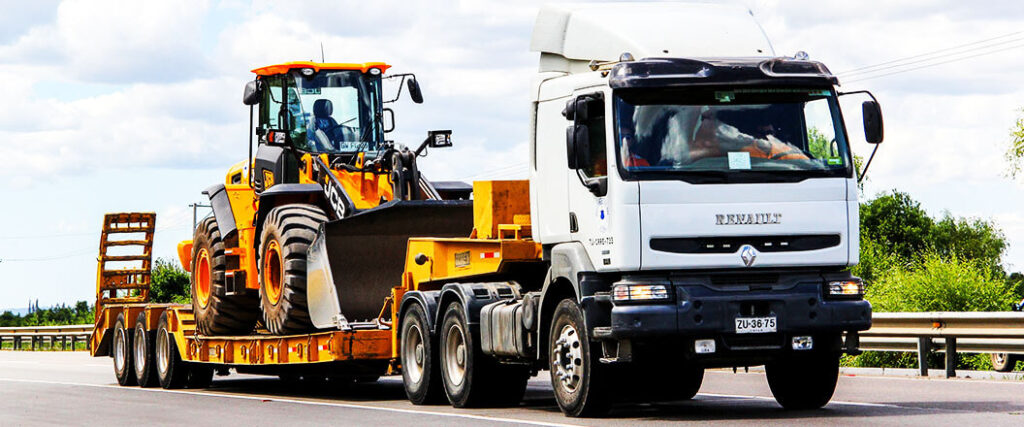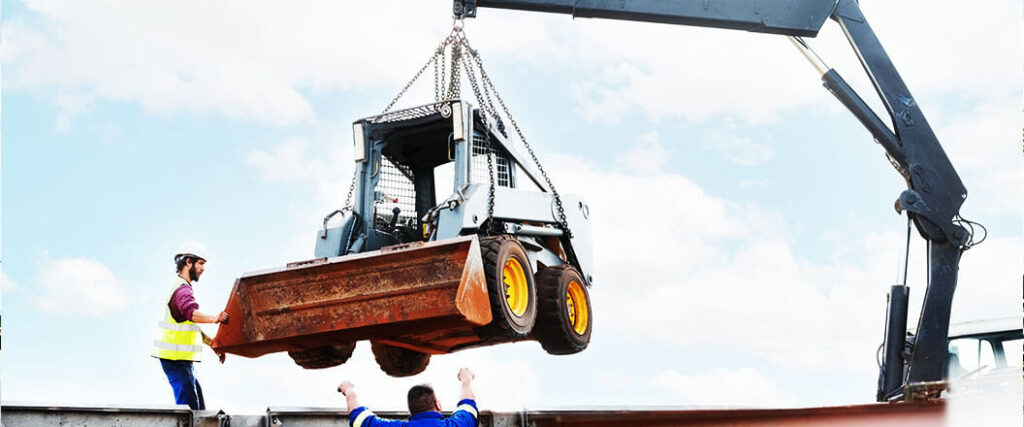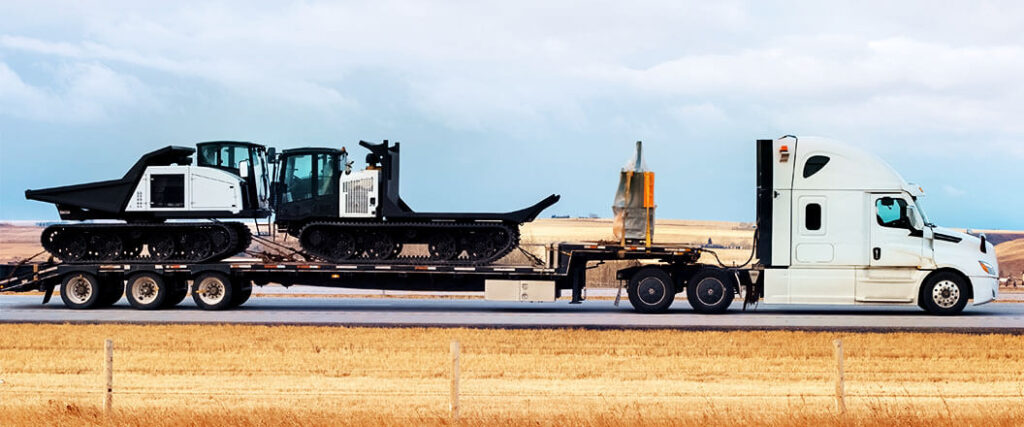The idea of heavy equipment transport can be daunting regardless of your experience or the industry that you’re in. Whether it’s an oversized cargo load that you’re transporting across the United States or a large tractor that you need to move only a short distance, transporting heavy equipment can be incredibly complicated.
The Department of Transportation (DOT) regulates heavy equipment transport on a state-by-state basis. If traveling across state lines, ensure you have the proper permits and shipping insurance required. Heavy shipments are typically loaded by crane or forklift and hauled using trailers such as flatbed, lowboy, and step deck trucks.
To help you stay on top of all of these rules and regulations, we’ve put together this comprehensive guide to assist you in transporting your heavy equipment.
Heavy haul truckload shipping typically involves an oversized load that is either heavier than the gross weight permitted by a standard U.S. truck license or larger in dimension than a typical load. For example, if you’re transporting construction equipment that is a non-standard size and that doesn’t fit on most truck beds, then you may need help from a heavy equipment transport service. In some cases, you may need to dismantle your equipment and ship it in multiple parts.
Heavy haul shipping also encompasses super load transport. This type of shipping is the mecca of heavy haul shipping. Super loads, or project cargo, are heavy haul shipments that even further exceed oversized shipping dimensions.
These massive shipments (either in length, width, height, weight, or all of the above) require more resources than standard oversized loads. Multiple pilot/escort vehicles, law enforcement, and road closures are often involved. Drivers and heavy haul trucking companies that offer super load transport as a service must be knowledgeable and coordinated to handle these often complex jobs.
Heavy equipment is transported on a variety of flatbed trailers. Flatbeds are a great option for transporting oversized loads because of all of the open space they allow. Some flatbed trailers that are commonly used include:
The type of trailer will change based on the specifics of the load.
The Federal Motor Carrier Safety Administration, or FMCSA for short, is a division of the United States Department of Transportation (USDOT) that regulates heavy haul restrictions. In particular, they set rules for the length, width and weight limits of commercial motor vehicles (CMVs) for interstate commercial traffic.
This means that it’s generally limited to a network of interstate freeways, U.S. highways and state highways that are collectively known as the National Network (NN). Assuming the route of the truck remains on the NN, they will not be subject to any state limits which could potentially be lower than federal limits. They only come into effect for intrastate commercial traffic if the vehicle is not on the NN.
In terms of height limits, there are no federal regulations. States set their own limits which can range from 13 feet 6 inches (4.11 m) to 14 feet (4.3 m). As a result, most trucks are between these two heights to ensure that, regardless of the state the truck is traversing, it stays within the state-regulated height limits.
However, certain height clearances, such as bridges and tunnels, need to be examined before the truck sets off onto the road. This is the responsibility of the heavy equipment transport company and its drivers.
Here are the federal gross weight limits for a Class 8 truck:
Truck drivers and heavy equipment transport specialists are responsible for checking the weight of their vehicles. This is usually done via a truck stop scale which may cost money to use.
These large trucks may also be subject to federal and state laws that regard limitations on truck length. This is often measured from bumper to bumper and may vary from state to state. As a result, this is yet another consideration to keep in mind when traveling across multiple states.
While these federal guidelines are important to know, the federal government tends to let states decide their own regulations for oversized heavy equipment loads. Therefore, you should be familiar with your state’s regulations regarding shipments like these.
In the case of shipments that travel multiple state lines, you’ll need to abide by the regulations of each state that your shipment travels through. Fortunately, most state regulations are fairly similar to one another and to the federal regulations they’re derived from.
State regulations can vary in regards to other elements of heavy equipment shipments such as:
Rather than going through the regulations of the state(s) that your freight will travel through, consider consulting with a trusted 3PL that can quickly give the answers you need.
Need assistance transporting a generator? Check out our article to learn more.

When it comes to freight shipping, the term “heavy equipment” can mean a lot of different things and the services are generally used by a wide variety of different industries and businesses. However, the most common types of heavy equipment hauling usually involves mining, construction, agricultural and industrial industries.
Some examples of heavy equipment that you might see going down the road on a flatbed trailer include construction equipment like:
Once you’ve dealt with all the regulations that come with transporting oversized loads, there are some preparations that you will have to get sorted to have a successful shipping experience.
Before your heavy equipment can be transported, the best possible route for it to be moved along needs to be established. Like other types of oversized loads, heavy equipment can only travel down certain routes due to its extreme dimensions.
For example, routes, where there are sharp turns or bridges with low clearances, need to be avoided. Sharp turns could cause the trailer and truck transporting the equipment to easily tip over. As for bridges with low clearance, heavy equipment won’t be able to pass through at all.

Start with a personalized quote today from our industry experts and get expertise route planning for your shipment.
Transmit times can vary a lot depending on the type of cargo you want to transport, the urgency, the route and also the distance. For instance, loading up heavy equipment such as construction vehicles or cars from a dealership can take a long time.
This is because loading the vehicles can take quite a bit of time. As a result, loading procedures can add to the transit time.
A general rule of thumb is to expect your shipment to travel around 500 miles driven per day. This means that if you want to transport something 1,500 miles away from your destination, you can expect it to take around 3-4 days in transit alone. This doesn’t include the loading and unloading of your cargo and it also doesn’t take added leeway into consideration.
Things like closed roads or complicated paths could add extra time to your equipment transport time, and freak weather accidents could force your driver to slow down and stop. Having escorts may also slow down the transit time especially if security is a concern and you want to be as thorough and protective of your cargo as possible.
So to recap, here are the main factors that can change your transit time:
Please keep in mind that these are estimated figures. The best way to get a more accurate transit time is to speak to us and request a quote for your heavy hauling needs. We’ll be able to provide a much more accurate quote once we know the exact distance and type of cargo that you’ll be moving.

All licensed heavy hauling companies are required to have some amount of liability and cargo insurance. After all, the last thing you want is for an incompetent driver to end up in an accident that damages your cargo and renders it useless. This is why shipping insurance is important since it can cover damage that occurs during the shipping process. It may also cover any mishandling during the loading and unloading of your cargo.
Here are some basic things to keep in mind when it comes to insurance and transporting heavy equipment.
The topic of insurance can be complicated, especially if you’ve never attempted to transport heavy equipment before. As a result, it’s never a bad idea to contact the shipping company directly to speak to them about insurance-related matters to make everything clear.
The last bit of preparations that you need to worry about is getting your load on a trailer and ready for transport. Loading the freight onto the trailer is likely the hardest part of the process. Unsurprisgnly, the heavy equipment is so large and heavy that lifting it by hand is not an option.
Therefore, this type of freight has to either be loaded by forklift, crane or the vehicle has to actually be driven onto the trailer if the trailer allows it. If crane services are used, you’ll have to cover the costs of using it and schedule a date for the crane service to load your freight.
Once safely on the trailer, the equipment needs to secured to the flatbed trailer it now rests on. This is done using chains and straps that will hold it into place. Lastly, you can choose to cover your heavy equipment to protect it from rain and other weather phenomenon.
That said, covering heavy equipment is sometimes optional. Most heavy equipment, like equipment used in construction, is built sturdy and able to withstand rough weather conditions. This means that covering the equipment won’t always be needed.
Need heavy equipment transported to an oil field? Check out our article to learn more.
We understand that you might have very specific or demanding needs from a transport company. In addition to just moving your heavy equipment across the country, you might want to transport it internationally to overseas clients or to start a new business location, such as a factory or commercial office. In a situation like this, you’ll want to hire the services of a specialist that is experienced in international heavy equipment transport. This can be incredibly costly, but it’s one of the most sensible and stress-free ways to transport large pieces of equipment overseas.
Here are some basics to help ensure that your overseas heavy equipment transport is successful.
There are many different complications that get in the way of smooth overseas transportation service. With all of the additional costs and considerations involved, you may find it incredibly difficult to stay on top of everything. With all of the forms to fill out, questions to ask and details to understand, it’s certainly not something that you’ll use for small jobs due to the amount of investment required for an international heavy equipment move. Whether it’s something seemingly innocent such as construction equipment or large and heavy machinery designed to equip an overseas production facility, everything falls under the same scrutiny and must be examined thoroughly before it’s able to leave the country with no worries.

Heavy equipment transport is certainly not a joke. It’s not something that you can simply hire from a random service and you’ll want to ensure that you have the best possible service in order to ensure that your items arrive safely and soundly.
You’ll need to find a service that is reliable and trustworthy, so we’ve put together a few tips to help you pick the right heavy equipment transport company for your needs.
First, don’t be afraid to ask questions. When you’re dealing with a company that will be helping you move oversize loads and heavy machinery, you want to make sure that you trust them and asking questions is a great way for them to earn that trust. Whether it’s a question about their company mission or concerns over their insurance policies, make sure you speak up and ask plenty of questions so that you can learn more about the company and its staff.
Speaking of insurance, pick a company that offers you some kind of guarantee or compensation should they damage your cargo. In the event that something bad does happen, you’ll want to be able to claim expenses and compensation in order to continue operating your business with minimal concerns.
Next, make sure you write a list of services that you require and ensure that the company you’re speaking to can meet those needs. Perhaps you need to move an abnormally-shaped piece of cargo or maybe you’re looking for escorts to help protect your cargo. Whatever your needs are, speak to the company and ensure that they’re able to meet your requirements. They should provide you with a comprehensive package that deals with all your concerns and needs so that you don’t need to contact multiple shipping companies in order to successfully move your heavy equipment from one location to another.
Lastly, make sure you make a full list of all of the equipment and cargo that you plan to ship. Doing this will help ensure that nothing gets lost during transit. Should something be lost, you can claim compensation assuming that the company is insured. So to sum it up, here are the main things to focus on when picking a heavy equipment transportation company:

Reach out to us at (855) 490-2433 or fill out our quick form and a live agent will be in touch shortly.
The amount you spend on transporting heavy equipment is dependent on a variety of different factors. Giving an exact amount is difficult, but there are ways that you can get a pretty good estimate on how much shipping you’re heavy equipment will cost you.
As we have already established earlier in this article, you’re heavy equipment shipment will be considered an oversized load. Most states do require that oversized shipments that are transported within their borders have permits. Depending on the state you need a permit for, you can expect pay somewhere between $15.00 to $70.00. Some states will also require you pay a $15.00 to process the application.
The distance from one destination to another is a factor that greatly shapes the costs. The further the distance the final destination is, the more fuel is required to get the shipment there. That means you can expect to spend more for destinations that are far away.
Another factor to consider are global events that cause disruptions in the supply chain, like higher fuel prices.. Shipping rates are going to be higher to compensate for these fuel costs.
The size of your shipment will also have an effect on transport costs. Large pieces of freight require manpower to load, unload and transport it to it’s next destination. Handling equipment so large is going to affect what your rate will be.
Additionally, you’ll also have to consider that hauling freight that is large and heavy is sure to burn up the fuel of the truck moving it much faster. This will also have an effect on what you pay for shipping.
To give you a better idea of what it will cost to ship heavy equipment, here are some price estimates for shipping certain types of construction equipment in the table below.
| Equipment | Cost |
| Excavator | $500-$5,500 |
| Bulldozer | $2850-$3300 |
| Motor Grader | $2000-$3000 |
| Trencher | $200-$400 |
If you’re in need of heavy equipment shipping, don’t hesitate to contact Heavy Haul and Oversized today. We’re confident that we can offer you an outstanding customer experience for all of your transport needs. Whether it’s an oddly-shaped piece of cargo or several construction vehicles that you need to move, we’re more than happy to help you.
We have relationships with small, but specialized carriers throughout the country who will be able to transport your heavy equipment where it needs to go. Fill out your free quote or call us today at (205) 768-6838 and experience the success that comes with using Heavy Haul and Oversized.
Heavy Haul and Oversized
315 NE 14th Street #4122
Ocala, FL 34470